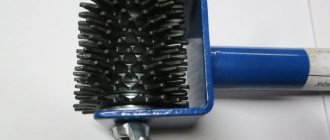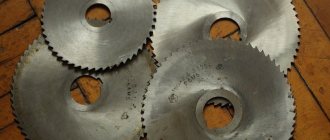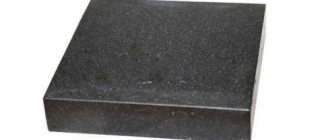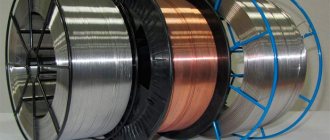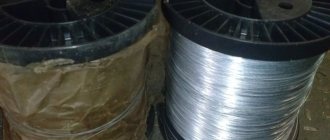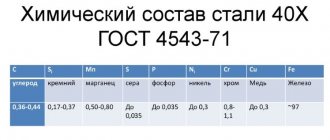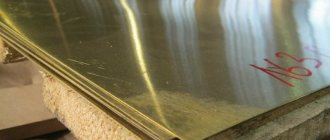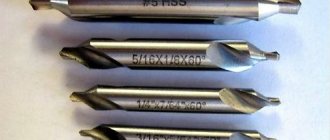For sanding and surface finishing work, it is important to select the correct abrasive material to minimize the risk of removing too much material and reduce the time and cost of the job.
Flap discs are made from the same abrasives as grinding discs, but their multilayer design makes it possible to process materials in a more gentle manner.
They are ideal for both initial sanding and finishing work. The advantages of petal circles include:
low noise level;
low heating during grinding;
long service life;
- high quality stripping
In this article, we will tell you how to choose the right disc, and also analyze the rules for effectively using a flap end grinding disc.
Choice of abrasive material
How a flap wheel works depends largely on the abrasive material used and the grit size.
ABRO discs use two main abrasives: aluminum oxide and zirconium dioxide.
Aluminum oxide (electrocorundum)
– the most common and affordable type of corundum. It is used for processing all ferrous metals, plastic, wood.
Uses of zirconium dioxide
as an abrasive material it ensures high productivity and long service life of the disc. Zirconium discs are especially good for stainless and carbon steel types. This wheel is more heat resistant, stronger and more durable, and remains sharp for a longer period of time.
The easiest way to tell what kind of abrasive material a flap disc is made from is to look at its color. If the abrasive is brown in color, you have an aluminum oxide abrasive wheel.
If the disk is blue, then, as a rule, it is made on the basis of zirconium.
In order to be 100% sure of the disc material, check the technical data indicated on it:
“A” – aluminum oxide
“ZA” – aluminum zirconate
(you can find out more about disc markings here: How to choose a cutting disc?)
Each type of grinding work corresponds to a certain grain size of the flap disk.
Table 1. Selecting disc grit.
The ABRO brand assortment includes all the types of grain described above:
100 mm is the minimum size. Suitable for small electric angle grinders (angle grinders) as well as pneumatic tools. Used for work in hard-to-reach places.
125 mm is the most popular size. Suitable for high power angle grinders.
There are other sizes, but these are the most widely used.
Selecting the thickness of the petals
Standard – for roughing of ferrous metals. The most accessible segment.
Thickened – also called HD or High Density. Contain on average 40% more petals compared to standard ones. They are processed more gently, have a longer service life, have less risk of damaging the surface, and are better sharpened. These are the discs ABRO produces.
Correct technique of use
To maximize the efficiency and longevity of your flap disc, it is important to select the correct pressure and angle when operating your angle grinder.
When working with flap discs, an angle grinder should contact the surface at an angle of 5 to 35 degrees. Each range has its own circle type:
1. Type 27 (according to GOST KLT -1) is best suited for finishing and applications where smaller grinding angles are required, from 0 to 15 degrees.
2. Type 29 (according to GOST KLT-2) is best suited for aggressive grinding at a large angle, from 15 to 25 degrees.
One of the popular mistakes associated with flap discs is putting too much pressure on the angle grinder during operation. In this case, the disk will not work fast enough, which can lead to premature wear and overheating. Too much pressure can also cause undercuts, gouges, or surface damage.
IMPORTANT! If you feel like pressing harder on the wheel when sanding, this is a sure sign that you need to use a coarser grit.
Another mistake is sanding at an obtuse angle to the surface. This technique increases pressure and stress on the edges of the disc, which shortens its service life.
When finishing welds on thin metal surfaces, it is important not to remove too much metal. You need to choose the least aggressive disk. For such work, we recommend a flap disc with a grit of 80 or 60.
Read also: Tank design for a gasoline burner for soldering
Do not judge the degree of wear of the petal disc by its external condition. Flap wheels are designed in such a way that, when used correctly, the blade will cut until the adhesive becomes visible.
Using these simple tips, you can save money on disks and become more efficient in your work.
The article was prepared with the support of experts from the DiamMarket company - products for stone processing.
A grinding disc is one of the types of abrasive tools, along with heads, segments, bars, abrasive belts and sandpapers, actively used for processing various types of surfaces. The abrasives used for the manufacture of grinding wheels are durable, highly hard substances: diamond, corundum, quartz, as well as artificial materials - electrocorundum, synthetic diamonds, silicon and boron carbide and others. The grains of these substances subject the surface of other materials to mechanical processing; in terms of their purpose, they can be compared with the teeth of a conventional saw, but located not along the edges, but along the perimeter of the disk. Grinding wheels are used to process many materials: carbon steel, glass, plastic, bronze, wrought iron and non-ferrous metals. In addition, they are used in tools for cutting brick, stone, ceramic tiles, and drywall.
Features of marking grinding products
The production of wheels is carried out in accordance with GOST; accordingly, their marking is also regulated by regulations. Typically, the main criteria for marking abrasive wheels are:
- Sanding material is a crumb of a special material that is characterized by high strength and good grinding properties.
- The size of the disk characterizes the diameter of the circle.
- Grain size – the degree of processing directly depends on it. The larger the grains, the more intensively and roughly the surface being treated is erased. Coarse grit is used when it is necessary to quickly remove a large amount of material and cut a large piece from a part. Fine is usually used for fine finishing, sanding and smoothing corners.
- Disc type - depends on the profile features of the new sanding wheel. Today there are 39 different types of profiles.
- Degree of hardness - this indicator has nothing to do with the hardness of the abrasive chips; it characterizes the ability of the binder material to hold grains on its surface and prevent them from tearing off during processing.
- Binder – indicates the material that acts as the base of the circle. A binder is necessary to form a circle of crumbs.
- Instability class - the accuracy of surface treatment depends on it. The higher the instability, the lower the quality of work. The reason for this is most often the irregular shape of the circle, uneven distribution of the binding material and displacement of the seat relative to the geometric center of the circle.
- Structure - indicates the ratio of the amount of abrasive and binding material, the presence of pores in the composition, the nature of the arrangement of grains and the uniformity of their distribution.
- Optimal rotation speed - calculated depending on the purpose of the emery, its structure, characteristics of the material used and shape. It is recommended to hold it to achieve optimal results.
In order to select the right tool, it is important to understand the features of the markings of grinding discs.
The basis
Abrasive paper can be made on different materials:
- The bulk of products with abrasive are produced on a paper basis. To increase the strength of the paper web to tearing, abrasion, and bending, it is impregnated with polymers and resins. Thanks to these compositions, the product also acquires moisture-resistant properties. But still, paper is a fragile object and is not suitable for intensive long-term work. Fine grain is applied to it.
- Fabric-based sandpaper is more resistant to abrasion and wear. The grain holds just as well, the canvas additionally has elasticity and resistance to moisture, intensive work with various materials, even with a sander, for which they produce velcro attachments.
- Combined fabric-paper fabric (two-layer) combines the best properties of previous materials. The product is elastic, resistant to abrasion, bending, and moisture. Coarse-grained sandpaper is produced on a combined basis.
On sale you can find paper with a sponge base. This one allows dust to pass through well, is not afraid of moisture, and is suitable for manual and mechanical work for a long time.
Types of grain size by material
Abrasive is made on different bases:
- Silicon carbide (carborundum) is suitable for working with hard surfaces made of metal and plastic.
- Pomegranate grains are hard and soft at the same time: such abrasive paper is able to remove unevenness from the surface of the wood and seal the fibers, so that the paint or varnish coating applies evenly.
- Ceramics are used to make coarse sandpapers used for smoothing wood.
- Aluminum oxide is a material of considerable price, but it also has an impressive service life for its “compatriots”: soft crystals break during grinding, smoothing the surface, but in their place smaller particles with the same sharp edges are formed.
- Diamond sandpaper is the most durable and expensive. It hardly wears out and is used mainly for machine processing of products in industry.
Grinding wheel grit
Grit size is perhaps the most important indicator, since the smoothness of the finished surface depends on the size of the abrasive. Based on the grain size index, you can clearly determine the thickness of the layer being removed, the degree of wear of the disc and the smoothness of the processing. Typically, tool manufacturers provide special tables that detail the characteristics of the wheel range, including grit size and purpose of the disc.
The grain of the wheel can be so small that it can be used for polishing glass. With its help, small scratches and chips are removed and the glass is returned to a perfectly smooth surface.
The most common types you can find are:
- grinding - the abrasive size ranges from No. 200 to No. 16;
- grinding powder - from No. 12 to No. 4;
- micro-grinding powder – M63-M14;
- fine micro-grinding powder – M10-M5.
Particle size is measured in micrometers. It is worth noting that the exact size of the abrasive can usually be determined only for artificial materials. When producing diamond wheels, it is impossible to choose the same size of chips, so when marking, two indicators are used, the minimum and maximum grain size.
Types of ligaments
In the production of abrasives, two main types of binders are used - organic and inorganic. The first option is produced from natural raw materials, and the second is produced using heat treatment of a particular synthetic substance, which leads to the production of a high-strength product.
Let us consider each group of connectives and their properties in more detail.
Abrasive type
Today, a large variety of materials are used in the production of emery. This allows you to achieve optimal characteristics of the disk, achieve its high strength, durability or processing accuracy.
The most commonly found materials are:
- Electrocorundum - used when working with metal products, usually wrought iron. It is characterized by high heat resistance and good adhesion to the binder. The abrasive is very strong and has high durability. The most common electrocorundum is normal. White electrocorundum is also common. The abrasive is more uniform and has sharp edges that sharpen themselves. Because of its properties, it is used for final processing of parts made of high-quality steels. Less commonly, you can find chromium, titanium and zirconium electrocorundum. The higher the marking number, the higher the strength of the circle.
- Silicon carbide is characterized by increased strength and at the same time significant fragility. It is labeled as 52-55C and is used when working with porcelain, granite, ceramics, glass and many other durable materials.
- Elbor is a very hard material, almost as good as diamond, but more fragile. Such circles are marked CBN, KNB.
- Diamond is a very durable natural material and is characterized by low fragility. Such discs are used in the machining of alloys based on iron, glass, ceramics and silicon.
Diamond wheels are divided into several types:
- normal strength (AC2);
- increased (AC4);
- high (AC6);
- single crystals (AC32).
Classification
A non-professional classification, familiar to many, divides grinding wheels into the following types:
Marking by size
The main indicators of the size of abrasive wheels that are used for marking are the outer and inner diameter, as well as the height or width of the disc. The outer diameter is designated by the capital Latin letter D, the inner diameter is d, the width or height of the disk is H. All designations are indicated in mm.
The size of the discs can range from 3 to 1100 mm.
Along with the size, you can often find an instability class, which is divided into 4 groups. The instability class is especially important when it is necessary to achieve high precision in the processing of materials. Discs that are ideally shaped and balanced are designated AA.
Acceptance rules
7.1. To monitor compliance of the wheels with the requirements of this standard, the manufacturer carries out acceptance control in accordance with GOST 15.309.
7.2. The sample size during acceptance control should be:
100 %
-
according to 5.9, 5.12.2;
10% of the lot, but not less than 5 pcs. -
according to 4.2, 5.4
-
5.6, 5.8;
5% of the lot, but not less than 5 pcs. -
according to 5.7.
The sample size during acceptance control of section 6 is
in accordance with GOST R 52588.
Structural density
The essence of the indicator of the structural density of an abrasive is the ratio of grains to the total volume of the disk, that is, grains and binder. The higher the grit density, the more material can be removed in one pass. Sometimes the lower the density, the better. For example, when sharpening. The disc self-cleans faster and does not overheat due to rapid heat dissipation, protecting the disc from deformation.
Typically the markings look like this:
- dense structure – from 1 to 4;
- average – from 5 to 7;
- open – 8, 9, 10;
- porous – 11, 12.
Ceramic, bakelite and vulcanite binders are usually used as binders. The first is the most common, it is based on sand, clay and quartz. These discs are highly durable, but they are also fragile. It is not recommended to use them for power processing.
Bakelite circles are based on resin. Such discs are highly resistant to temperature changes during operation. Volcanic bond is rarely used and usually in highly specialized areas; it is based on rubber.
Catalog >> News >> Marking and selection of cutting and grinding wheels
Marking and selection of cutting and grinding wheels
Grinding wheels are characterized by geometric shape (type), type of abrasive material, its grain size, bond type, hardness, etc. And when choosing a grinding wheel, such characteristics as the degree of hardness or structure may be more significant than the type of abrasive.
The complete markings for grinding wheels contain:
- circle type;
- its dimensions;
- type of abrasive material;
- grit number;
- degree of hardness;
- structure (the relationship between the abrasive, bond and pores in the body of the tool);
- type of ligament;
- maximum speed;
- accuracy class;
- imbalance class.
| Type | Dimensions, mm | Abrasive | Grain | Hardness | Structure | Bunch | Speed, m/s | Accuracy class | Unbalance class |
| 1 | 150x16x32 | 25A | F46 | L | 6 | V | 35 | B | 3 |
The marking of wheels, made in accordance with various editions of GOSTs, has some differences regarding the designations of grain size, hardness, grade of abrasive and binder. Manufacturers label their wheels differently, using old or new designations and excluding certain characteristics. Below are examples of deciphering the designations of grinding wheels.
Grinding wheel markings
1 - abrasive material: 25A - white electrocorundum; 2 - grain size (old marking): 60 (according to GOST it should be 63) - 800-630 microns; 3 - hardness: K - medium-soft; 4 - structure: 6 - average; 5 - ligament: V - ceramic; 6 — imbalance class: 2
Grinding wheel markings
1 - abrasive material: 25A - white electrocorundum; 2 - grain size (old marking): 60 (according to GOST it should be 63) - 800-630 microns; 3 - hardness: KL - depending on the circumstances, can be K or L - medium-soft; 4 - ligament: V - ceramic.
Grinding wheel designation
1 - abrasive material: 25A - white electrocorundum; 2 - grain size (old marking): 25 - 315-250 microns; 3 - hardness (old marking): SM2 - medium-soft; 4 - structure: 6 - average; 5 - bond (old marking): K - ceramic; 6 — accuracy class: B 7 — imbalance class: 3
Marking of abrasive wheel
1 - abrasive material: 25A - white electrocorundum; 2 - grain size: F46 - average size 370 microns; 3 - hardness: L - medium-soft; 4 - structure: 6 - average; 5 - ligament: V - ceramic; 6 — peripheral speed: 35 m/s; 7 — accuracy class: B 8 — imbalance class: 3
Grinding wheel designation
1 - abrasive material: 14A - normal electrocorundum; 2 - grain size: F36-F30 - extended range including F36 (average size 525 microns) and F30 (average size 625 microns); 3 - hardness: QU - depending on the circumstances, it can be medium-hard, hard, very hard; 4 - bond: BF - bakelite with reinforcing elements; 5 — imbalance class: 1
The choice of grinding wheel brand should be made taking into account all its characteristics.
Types of grinding wheels and their sizes
| 1 | 150x16x32 | 25A | F46 | L | 6 | V | 35 | B | 3 |
The following types of grinding wheels are produced (in parentheses the designations according to the old GOST 2424-75 are given):
- 1 (PP) - straight profile;
- 2 (K) - ring;
- 3 (3P) - conical;
- 4 (2P) - double-sided conical;
- 5 (PV) - with one-sided groove;
- 6 (ChTs) - cup cylindrical;
- 7 (LDPE) - with two grooves;
- 9 - with double-sided groove;
- 10 (PVDS) - with double-sided groove and hub;
- 11 (CHK) - conical cup;
- 12 (T) - disc-shaped;
- 13 - disc-shaped;
- 14 (1T) - disc-shaped;
- 20 - with one-sided conical groove;
- 21 - with double-sided conical groove;
- 22 - with a conical recess on one side and a cylindrical recess on the other;
- 23 (PVK) - with conical and cylindrical grooves on one side;
- 24 - with conical and cylindrical recesses on one side and a cylindrical recess on the other;
- 25 - with conical and cylindrical recesses on one side and conical on the other;
- 26 (PVDK) - with conical and cylindrical recesses on both sides;
- 27 - with a recessed center and reinforcing elements;
- 28 — with a recessed center;
- 35 - straight profile, working with the end;
- 36 (PN) - with pressed-in fasteners;
- 37 - ring with pressed fasteners;
- 38 - with one-sided hub;
- 39 - with a double-sided hub.
Some types of grinding wheels
All types are described in GOST 2424-83.
In addition to the profile shape, circles are characterized by the size DxTxH, where D is the outer diameter, T is the height, H is the diameter of the hole.
Types of diamond and CBN wheels are regulated by GOST 24747-90. The marking of the shape of CBN and diamond wheels consists of 3 or 4 characters that carry information about the cross-sectional shape of the body, the cross-sectional shape of the CBN-containing or diamond-bearing layer, the location of the latter on the wheel, and the design features of the body (if any).
Designation of a grinding wheel with the shape of the body 6, the shape of the diamond-bearing or elboron-containing layer A, with the location of the diamond-bearing or elboron-containing layer 2, with the design features of the body C.
Designation of diamond or CBN grinding wheels
All types are described in GOST 24747-90.
The type and size of the wheel are selected based on the type and configuration of the surfaces being ground, as well as the characteristics of the equipment or tool used.
The choice of wheel diameter usually depends on the spindle speed on the selected machine and on the ability to provide an optimal peripheral speed. Specific wear will be the least with the largest diameter circle size. Smaller wheels have fewer grains on the working surface, each grain has to remove more material, and therefore they wear out faster. When working with small diameter wheels, uneven wear is often observed.
When choosing a diamond wheel, it is advisable to pay attention to the width of the diamond-bearing layer. When working “on the pass” it should be relatively large. When grinding using the “plunge” method, the width of the diamond coating should be commensurate with the width of the surface being processed. Otherwise, ledges may appear on the surface of the circle.
Abrasives
| 1 | 150x16x32 | 25A | F46 | L | 6 | V | 35 | B | 3 |
The most commonly used abrasive materials for grinding wheels are: electrocorundum, silicon carbide, CBN, diamond.
Electrocorundum
Available in the following grades: white -
22A
,
23A
,
24A
,
25A
(the higher the number, the higher the quality);
normal - 12A
,
13A
,
14A
,
15A
,
16A
;
chromium - 32A
,
33A
,
34A
;
titanium - 37A
;
zirconium - 38A
and others.
Silicon carbide
.
Two types of silicon carbide are available: black - 52С
,
53С
,
54С
,
55С
and green -
62С
,
63С
,
64С
, differing from each other in some mechanical properties and color. Green carbide is more fragile than black carbide.
Diamond
widely used for the manufacture of diamond grinding wheels used for finishing and sharpening carbide tools, processing parts made of hard alloys, optical glass, ceramics, etc. It is also used for dressing grinding wheels made of other abrasive materials. When heated in air to 800°C, diamond begins to burn.
Diamond grinding wheels
Elbor
(CNB, CBN, borazone, cubonite) is a cubic modification of boron nitride. Having the same hardness as diamond, it is significantly superior to the latter in heat resistance.
CBN wheels for full-profile sharpening of band saws
Abrasive materials are characterized by hardness, granularity, abrasive ability, strength, heat and wear resistance. High hardness is the main distinguishing feature of abrasive materials. Below are comparative characteristics of microhardness and heat resistance of the main abrasive materials.
| Materials | Microhardness, kgf/mm2 |
| Diamond | 8000-10600 |
| Elbor (cubic boron nitride, CBN) | 8000-10000 |
| Boron carbide | 4000-4800 |
| Silicon carbide green | 2840-3300 |
| Silicon carbide black | 2840-3300 |
| Monocorundum | 2100-2600 |
| Electrocorundum white | 2200-2600 |
| Titanium electrocorundum | 2400 |
| Chromium electrocorundum | 2240-2400 |
| Electrocorundum normal | 2000-2600 |
| Corundum | 2000-2600 |
| Quartz | 1000-1100 |
| Titanium carbide | 2850-3200 |
| Wolfram carbide | 1700-3500 |
| Hard alloy T15K6, VK8 | 1200-3000 |
| Mineral ceramics TsM332 | 1200-2900 |
| High-speed steel hardened P18 | 1300-1800 |
| Carbon tool steel sealed U12 | 1030 |
| Carbon steel sealed St.4 | 560 |
| Materials | Heat resistance, °C |
| Elbor | 1300-1500 |
| Diamond | 700-900 |
| Silicon carbide | 1200-1300 |
| Electrocorundum | 1300 |
| Boron carbide | 500-600 |
| Mineral ceramics | 1200 |
| Carbide alloy VK8 | 900 |
| High speed steel P18 | 600 |
| Carbon tool steel U12 | 200 |
The choice of one or another abrasive material is largely determined by the characteristics of the material being processed.
| Abrasive | Application |
| Electrocorundum normal | It has high heat resistance, good adhesion to the binder, mechanical strength of the grains and significant viscosity necessary for performing operations with variable loads. Processing of materials with high tensile strength (steel, ductile iron, iron, brass, bronze). |
| Electrocorundum white | It is more homogeneous in its physical and chemical composition, has higher hardness and sharp edges, has better self-sharpening ability and provides lower roughness of the processed surface compared to normal electrocorundum. Processing of the same materials as normal electrocorundum. Provides less heat generation, higher surface finish and less wear. Grinding of high-speed and alloy tool steels. Processing of thin-walled parts and tools, when the removal of heat generated during grinding is difficult (stamps, gear teeth, threaded tools, thin knives and blades, steel cutters, drills, woodworking knives, etc.); parts (flat, internal and profile grinding) with a large contact area between the wheel and the surface being processed, accompanied by abundant heat generation; for finishing sanding, honing and superfinishing. |
| Silicon carbide | It differs from electrocorundum in its increased hardness, abrasive ability and fragility (the grains have the form of thin plates, as a result of which their fragility increases during operation; in addition, they are less well held by the bond in the tool). Green silicon carbide differs from black silicon carbide in increased hardness, abrasive ability and fragility. Processing of materials with low tensile strength, high hardness and fragility (hard alloys, cast iron, granite, porcelain, silicon, glass, ceramics), as well as very viscous materials ( heat-resistant steels and alloys, copper, aluminum, rubber). |
| Elbor | It has the highest hardness and abrasive ability after diamond; has high heat resistance and increased fragility; inert to ironGrinding and finishing of hard-to-cut steels and alloys; fine grinding, sharpening and finishing of high-speed steel tools; finishing and final grinding of high-precision workpieces made of heat-resistant, corrosion-resistant and high-alloy structural steels; finishing and final grinding of machine guides and lead screws, the processing of which is difficult with conventional abrasive tools due to large thermal deformations. |
| Diamond | Has high wear resistance and reduced heat resistance; chemically active towards iron; has increased fragility and reduced strength, which promotes self-sharpening; synthetic diamond of each subsequent grade (from AC2 to AC50) differs from the previous one in higher strength and less fragility. Grinding and finishing of brittle and high-hard materials and alloys (hard alloys, cast iron, ceramics, glass, silicon); fine grinding, sharpening and finishing of carbide cutting tools. |
Diamond wheels are capable of processing material of any hardness. However, you need to keep in mind that diamond is very fragile and does not withstand shock loads well. Therefore, it is advisable to use diamond wheels for final processing of carbide tools, when it is necessary to remove a small layer of material and there is no shock load on the grain. In addition, diamond has relatively low heat resistance, so it is advisable to use it with a coolant.
Grain
| 1 | 150x16x32 | 25A | F46 | L | 6 | V | 35 | B | 3 |
Abrasive grain size is a characteristic of grinding wheels that determines the cleanliness of the resulting surface. The grain is either an intergrowth of crystals, or a separate crystal, or its fragments. Like all solids, it is characterized by three dimensions (length, width and thickness), but for simplicity we operate with one - width. Many parameters depend on the grain size - the amount of metal removed in one pass, the cleanliness of the processing, grinding performance, wheel wear, etc.
According to GOST 3647-80, in the designation of the grain size of grinding wheels, the grain size is indicated in units equal to 10 microns (20 = 200 microns), for micropowders - in microns with the addition of the letter M.
In the new GOST R 52381-2005, which basically corresponds to the international standard FEPA, the grain size of grinding powders is indicated by the letter F with a number. The higher the number, the finer the grain and vice versa.
Diamond and CBN wheels have their own grain size designations. Their grain size is indicated by a fraction, the numerator of which corresponds to the size of the side of the upper sieve in microns, and the denominator corresponds to the size of the lower sieve.
The table below shows the ratios of grinding wheel grit according to old and current standards.
| Designation according to GOST 3647-80 | Designation according to GOST 9206-80 (diamond powders) | Size, microns | FEPA | |
| Designation for abrasive materials excluding flexible materials | Average size, microns | |||
| F 4 | 4890 | |||
| F 5 | 4125 | |||
| F 6 | 3460 | |||
| F 7 | 2900 | |||
| 200 | 2500/2000 | 2500-2000 | F 8 | 2460 |
| F 10 | 2085 | |||
| 160 | 2000/1600 | 2000-1600 | F 12 | 1765 |
| 125 | 1600/1250 | 1600-1250 | F 14 | 1470 |
| 100 | 1250/1000 | 1250-1000 | F 16 | 1230 |
| F 20 | 1040 | |||
| 80 | 1000/800 | 1000-800 | F 22 | 885 |
| 63 | 800/630 | 800-630 | F 24 | 745 |
| 50 | 630/500 | 630-500 | F 30 | 625 |
| F 36 | 525 | |||
| 40 | 500/400 | 500-400 | F 40 | 438 |
| 32 | 400/315 | 400-315 | F 46 | 370 |
| 25 | 315/250 | 315-250 | F 54 | 310 |
| F 60 | 260 | |||
| 20 | 250/200 | 250-200 | F 70 | 218 |
| 16 | 200/160 | 200-160 | F 80 | 185 |
| 12 | 160/125 | 160-125 | F 90 | 154 |
| F 100 | 129 | |||
| 10 | 125/100 | 125-100 | F 120 | 109 |
| 8 | 100/80 | 100-80 | F 150 | 82 |
| 6 | 80/63 | 80-63 | F 180 | 69 |
| 5, M63 | 63/50 | 63-50 | F 220 | 58 |
| F 230 | 53 | |||
| 4, M50 | 50/40 | 50-40 | F 240 | 44,5 |
| M40 | 40/28 | 40-28 | F 280 | 36,5 |
| F 320 | 29,2 | |||
| M28 | 28/20 | 28-20 | F 360 | 22,8 |
| M20 | 20/14 | 20-14 | F 400 | 17,3 |
| M14 | 14/10 | 14-10 | F 500 | 12,8 |
| M7 | 10/7 | 10-7 | F 600 | 9,3 |
| M5 | 7/5 | 7-5 | F 800 | 6,5 |
| M3 | 5/3 | 5-3 | F 1000 | 4,5 |
| 3/2 | 3-2 | F 1200 | 3,0 | |
| 2/1 | 2-1 | F 1500 | 2,0 | |
| F 2000 | 1,2 | |||
| 1/0 | 1 and | |||
| 1/0,5 | 1-0,5 | |||
| 0,5/0,1 | 0,5-0,1 | |||
| 0,5/0 | 0.5 and | |||
| 0,3/0 | 0.3 and | |||
| 0,1/0 | 0.1 and | |||
The choice of wheel grain size should be determined by a number of factors - the type of material being processed, the required surface roughness, the amount of allowance to be removed, etc.
The smaller the grain size, the cleaner the processed surface is. However, this does not mean that finer grain size should be preferred in all cases. It is necessary to choose the grain size that is optimal for a particular processing. Fine grain gives a higher surface cleanliness, but at the same time can lead to burning of the processed material and clogging of the wheel. Using fine grains reduces grinding performance. In general, it is advisable to choose the largest grain size provided that the required cleanliness of the treated surface is ensured.
If it is necessary to reduce surface roughness, the grain size must be reduced. Larger allowances and increased productivity require larger grits.
In general, the harder the material being processed and the lower its viscosity, the higher the wheel grit can be.
| Grit numbers according to GOST 3647-80 | Grit numbers according to GOST R 52381-2005 | Purpose |
| 125; 100; 80 | F14; F16; F20; F22 | Dressing of grinding wheels; manual roughing operations, cleaning of blanks, forgings, welds, castings and rolled products. |
| 63; 50 | F24; F30; F36 | Preliminary round external, internal, centerless and flat grinding with surface roughness of 5-7 cleanliness classes; finishing of metals and non-metallic materials. |
| 40; 32 | F40; F46 | Preliminary and final grinding of parts with surface roughness of 7-9 classes of cleanliness; sharpening cutting tools. |
| 25; 20; 16 | F54; F60; F70; F80 | Finish grinding of parts, sharpening of cutting tools, preliminary diamond grinding, grinding of shaped surfaces. |
| 12; 10 | F90; F100; F120 | Diamond finishing grinding, sharpening of cutting tools, finishing grinding of parts. |
| 8; 6; 5; 4 | F150; F180; F220; F230; F240 | Finishing of cutting tools, thread grinding with fine pitch threads, finishing grinding of parts made of hard alloys, metals, glass and other non-metallic materials, fine honing. |
| M40-M5 | F280; F320; F360; F400; F500; F600; F800 | Final finishing of parts with an accuracy of 3-5 microns or less, roughness of 10-14 cleanliness classes, superfinishing, final honing. |
Hardness of grinding wheels
| 1 | 150x16x32 | 25A | F46 | L | 6 | V | 35 | B | 3 |
The hardness of the grinding wheel should not be confused with the hardness of the abrasive material. These are different concepts. The hardness of the grinding wheel characterizes the ability of the bond to hold abrasive grains from being torn out under the influence of the material being processed. It depends on many factors - the quality of the bond, the type and shape of the abrasive, and the wheel manufacturing technology.
Wheel hardness is closely related to self-sharpenability—the ability of an abrasive wheel to regain its cutting ability by breaking down or removing dull grains. During operation, the wheels intensively self-sharpen due to the splitting of the cutting grains and their partial chipping out of the bond. This ensures that new grains enter into the work, thereby preventing the appearance of burns and cracks in the material being processed. The lower the hardness of the wheel, the higher the self-sharpening ability. Based on hardness, circles are divided into 8 groups.
| Name | Designation according to GOST 19202-80 | Designation according to GOST R 52587-2006 |
| Very soft | VM1, VM2 | F, G |
| Soft | M1, M2, M3 | H, I, J |
| Medium soft | SM1, SM2 | K, L |
| Average | C1, C2 | M, N |
| Medium-hard | ST1, ST2, ST3 | O, P, Q |
| Solid | T1, T2 | R, S |
| Very hard | VT | T,U |
| Extremely hard | Thu | V, W, X, Y, Z |
The choice of grinding wheel hardness depends on the type of grinding, the accuracy and shape of the parts being ground, the physical and mechanical properties of the material being processed, the type of tool and equipment.
In practice, in most cases, medium-hard wheels are used, which have a combination of relatively high performance and sufficient durability. A slight deviation of the wheel characteristics from the optimal one leads either to burns and cracks of the sharpened surface, when the hardness of the wheel is higher than required, or to intense wear of the wheel and distortion of the geometric shape of the sharpened tool, when the hardness of the wheel is insufficient. Wheels for sharpening tools with inserts made of hard alloys must be selected with particular precision in terms of hardness.
Here are some recommendations that may be useful when choosing grinding wheels based on hardness. When sharpening tools with carbide cutters, the wheel must have high self-sharpenability. Therefore, when sharpening them, wheels of low degrees of hardness are used - H, I, J (soft), less often K. The more tungsten or titanium carbides in the hard alloy, the softer the grinding wheel should be.
When it is required to maintain high precision of shape and size, preference is given to those types of grinding wheels that have increased hardness.
When using cutting fluids, grinding uses harder wheels than when grinding without cooling.
Wheels on a bakelite bond should have a hardness 1-2 levels higher than wheels on a ceramic bond.
To prevent burns and cracks, softer circles should be used.
Structure
| 1 | 150x16x32 | 25A | F46 | L | 6 | V | 35 | B | 3 |
The structure of a tool is usually understood as the percentage of the volume of abrasive material per unit volume of the tool. The more abrasive grain per unit volume of the wheel, the denser the structure of the tool. The structure of the abrasive tool affects the amount of free space between the grains.
| Structure | Designation |
| Dense | 1, 2, 3, 4 |
| Average | 5, 6, 7 |
| Open | 8, 9, 10 |
| Highly porous | 11, 12 |
When sharpening cutting tools, it is advisable to use wheels with more free space between the grains, as this makes it easier to remove chips from the cutting zone, reduces the possibility of burns and cracks, and facilitates cooling of the tool being sharpened. For sharpening cutting tools, wheels on a ceramic bond of 7-8th structure are used, and wheels on a bakelite bond - 4-5th structure.
Bunch
| 1 | 150x16x32 | 25A | F46 | L | 6 | V | 35 | B | 3 |
In the manufacture of grinding wheels, abrasive grains are bonded to the base and to each other using a bond. The most widely used binders are ceramic, bakelite and vulcanite.
Ceramic bond
It is made from inorganic substances - clay, quartz, feldspar and a number of others by grinding them and mixing them in certain proportions.
Ceramic bonded grinding wheels are marked with the letter ( V
).
Old designation - ( K
)
The ceramic bond gives the abrasive tool rigidity, heat resistance, shape stability, but at the same time increased fragility, as a result of which it is undesirable to use wheels with a ceramic bond under shock loads, for example, during rough grinding.
Bakelite bond
mainly consists of an artificial resin - bakelite.
The marking of circles with bakelite has a Latin letter ( B
) in its designation.
The old designation is ( B
). Compared to ceramic, bakelite binder has greater elasticity and elasticity, heats the metal being processed less, but has lower chemical and temperature resistance, and worse edge resistance.
Bakelite bond can be with reinforcing elements ( BF
, old designation -
BU
), with graphite filler (
B4
, old designation -
B4
).
Vulcanite bond
is a vulcanized synthetic rubber.
The abrasive wheel is marked with the letter ( R
).
The old designation is ( B
).
In most cases, abrasive wheels on ceramic or bakelite bonds are used. Both have their own characteristics, which determine their choice for a particular job.
The advantages of a ceramic binder include strong fixation of grain in the binder, high heat and wear resistance, good preservation of the working edge profile, and chemical resistance. The disadvantages are increased fragility, reduced bending strength, high heat generation in the cutting zone, and, consequently, a tendency to burn the material being processed.
The advantages of the bakelite bond are elasticity, good self-sharpening of the wheel due to the reduced strength of grain fixation in the bond, and reduced heat generation. The disadvantages are more intense wear compared to a ceramic bond, reduced edge resistance, low resistance to coolants containing alkalis, low heat resistance (bakelite begins to become brittle and burn out at temperatures above 200°C).
Accuracy class
| 1 | 150x16x32 | 25A | F46 | L | 6 | V | 35 | B | 3 |
The accuracy of the dimensions and geometric shape of abrasive tools is determined by three AA
,
A
and
B.
_
For less critical abrasive processing operations, class B
.
A
tool is more accurate and of higher quality .
For work in automatic lines, on high-precision and multi-circuit machines, high-precision AA
. It is distinguished by higher accuracy of geometric parameters, uniformity of grain composition, balance of abrasive mass, and is made from the best grades of grinding materials.
Unbalance class
| 1 | 150x16x32 | 25A | F46 | L | 6 | V | 35 | B | 3 |
The imbalance class of a grinding wheel characterizes the imbalance of the wheel mass, which depends on the accuracy of the geometric shape, the uniformity of mixing of the abrasive mass, the quality of pressing and heat treatment of the tool during its manufacturing process. Four classes of permissible imbalance of the mass of circles have been established ( 1
,
2
,
3
,
4
). Unbalance classes have nothing to do with the accuracy of balancing the wheels and flanges before installing them on the grinding machine.
Catalog >> News >> Marking and selection of cutting and grinding wheels
Abrasive hardness degree
The hardness indicator is the degree to which the abrasive is retained on the surface of the wheel. There are several varieties of circles, from very soft (VM) to extremely hard (HH). The most universal are the circles of medium hardness, suitable for a wide range of materials, therefore they are usually used in everyday life.
This parameter should be treated with special care, since an incorrectly selected disc wears out faster, can be destroyed during processing, damage the material being processed, or fail to produce results at all, even after several repetitions of grinding.
Control methods
8.1. Control of circle sizes is carried out using universal or special measures and measuring instruments.
8.2. Dimensions for reference, radii of curvature
R are determined by equipment and are not controlled.
8.3. Control according to 5.9, 5.12.2 is carried out visually.
8.4. Hardness control - according to GOST R 52587, GOST R 52710.
8.5. Imbalance control
—
according to GOST 3060.
Note
—
Control of unbalance of wheels with D
£
250 mm and types 2, 6, 11, 35, 36, 37 may not be carried out.
8.6. Control of radial and axial runout is carried out according to a technical document approved in the prescribed manner, using a dial indicator in accordance with GOST 577 with a division value of 0.01 mm.
8.7. Mechanical strength tests
-
according to GOST R 52588, GOST 30513.
Note - Until 07/01/2010, mechanical strength tests of wheels of types 2, 35, 36, 37 may not be carried out.
8.8. The grinding coefficient
K is calculated using the formula
where Qm
—
volume of metal removed, mm3;
Qa
—
volume of the worn part of the wheel (taking into account the wheel consumption for dressing).
